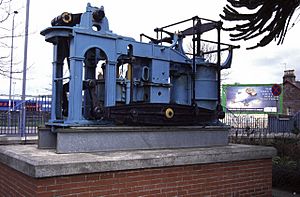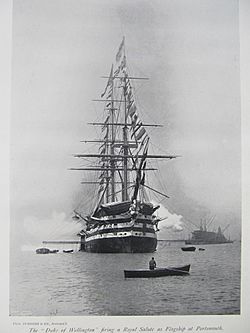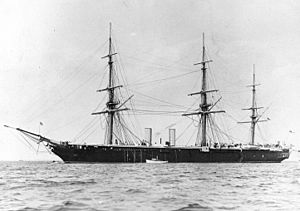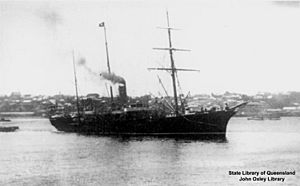Robert Napier and Sons facts for kids

Robert Napier and Sons was a very famous company that built ships and ship engines. It was started by Robert Napier in 1826 in Govan, Glasgow, near the River Clyde. Later, in 1841, they moved to Govan to have more room. His sons, James and John, joined the business in 1853.
People said that everyone who built ships or engines on the River Clyde learned a lot from Napier's success. By the 1840s, it was known as the best company of its kind in Britain. Many other companies were even started by people who used to work for Robert Napier.
After Robert Napier passed away in 1876, the company was sold in 1877. A group of engineers, led by the previous manager A. C. Kirk, bought it. The company kept building ships and engines until 1900. Then, it became part of another big company called William Beardmore and Company.
Contents
How It Started
In 1800, there were no companies building ships in Glasgow. But in 1815, when he was 23, Robert Napier started his own smith business in Glasgow.
Building Engines
In 1821, Robert Napier took over a factory called Camlachie foundry. He chose David Elder to be his works manager. David Elder later became the father of another famous shipbuilder, John Elder.
First, they made water pipes for the city. Then, they built a stationary engine (an engine that stays in one place). In 1823, they built Napier's first engine for a ship called Leven. David Elder designed many of these engines. They won contracts to build engines for a steamer called Eclipse in 1826. Four years later, they built engines for ships of the Glasgow Steam Packet Company. In 1834, they got a contract to supply engines for the Dundee and London Shipping Company.
In 1828, Robert Napier made his business bigger by taking over another factory called Vulcan Foundry. Two years later, he gave the Camlachie factory to one of his brothers. In 1836, he rented (and later bought in 1841) his cousin David Napier's Lancefield Quay Foundry and Docks. This was on the north side of the Clyde River.
At Lancefield, in 1836, he built Berenice. This was the first steamer for the East India Company. He hired another company, John Wood and Company, to build the ship's body. They also built Zenobia and, in 1841, HMS Akbar. His first contract to build a steamer for the British government was in 1840 for HMS Vesuvius, followed by HMS Stromboli.
Between 1843 and 1864, the company built 114 ships. By 1864, more than 3,000 people worked there. The yard built the first ships for the famous Cunard Line and many more later.
Building Ship Bodies from Iron and Steel
From 1842, Robert Napier and Son started building their own ships with iron bodies. They built these at a new yard across the Clyde River in Govan. At first, they built river steamers. Before this, they used to hire other companies to build wooden ship bodies. In 1848, they bought a factory called Parkhead Forge to make their own iron plates and parts. They started using steel to build ship bodies in the early 1880s.
Working with Cunard
Between 1840 and 1855, Napier's supplied engines for all the paddle ships of the Cunard Line. The wooden bodies for these ships were made by John Wood and Company and Robert Steele & Company. In 1850, Napier's started building iron-hulled river steamers. Then, they built ships for the deep sea. In 1852, they launched a screw steamship for the Peninsular and Oriental Steamship Company.
- RMS Persia, a large iron paddle steamer, was launched from Napier's yard in 1854. It was one of the biggest ships afloat at that time.
- Napier's supplied engines for 52 more ships for the Royal Navy.
- Their engines were also used a lot by private ship owners.
- They supplied engines to 29 different foreign governments.
Ships built for the Royal Navy included:
- Erebus
- Black Prince
- Hector
- Audacious
- Invincible
- Hotspur
- Northampton
These ships were all covered in armor. Together, they weighed 26,938 tons and their engines produced 5,450 horsepower.
- Danish Navy: One turret ship (a ship with rotating gun towers).
- Ottoman government: Three ships, each weighing 4,000 tons with 400 horsepower engines.
- Osmaniye
- Aziziye
- Orhaniye
- Dutch government: Two ships, each weighing 3,000 tons with 500 horsepower.
- Japanese government: The SS Meiji Maru was built for the Japanese government. It was used to help maintain lighthouses.
How the Company Was Managed
James Napier took over running the company after his father, Robert, officially retired in 1852. But James then left it to his younger brother John in 1857. The older brother, James (1821–1879), was a very important marine engineer of his time. However, the company started to lose its leading position in new technologies.
The company faced some money problems in 1859. This was because it was difficult to build HMS Black Prince exactly as the Admiralty (the British Navy) wanted. Robert Napier and his sons couldn't agree on what to do next with the business. In 1871, they had to sell the Parkhead Forge factory. After this, Robert Napier was convinced to fully retire. The brothers were then able to make the company financially stable again.
New Owners in 1877
After Robert Napier died, new partners took over in 1877. This group was led by Dr. Kirk, who used to be the company's manager. They built a ship called SS Aberdeen for George Thompson's Aberdeen White Star Line. This ship had an iron body and a new type of engine called a triple expansion engine. It was delivered in 1881. The Aberdeen was designed to travel to Australia through the Suez Canal. It was sold to Turkey in 1906 and eventually taken apart for scrap in 1919.
Cool Inventions
In late 1881, they delivered a ship called Parisian to the Allan Line. This ship was special because it was the first steel-hulled ship to cross the Atlantic Ocean!
The engine of the Aberdeen ship was very important. It was the first of its kind and became the model for thousands of triple expansion engines built in the years that followed.
More About Napier's Ships
The Caledonian Maritime Research Trust has a list of ships built on the Clyde River. Their database shows that Robert Napier and Sons built 256 vessels.




